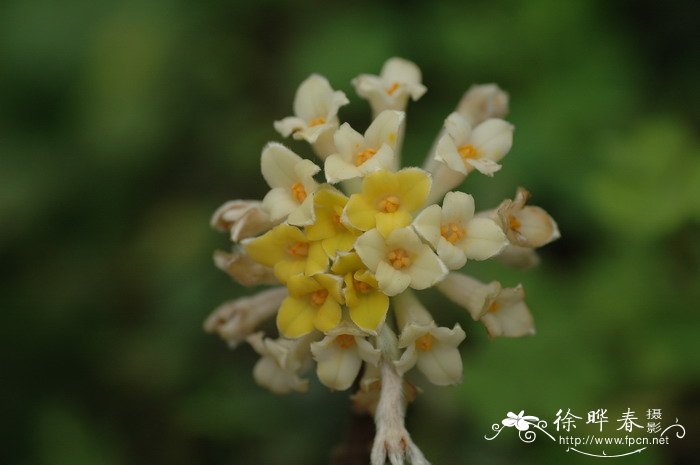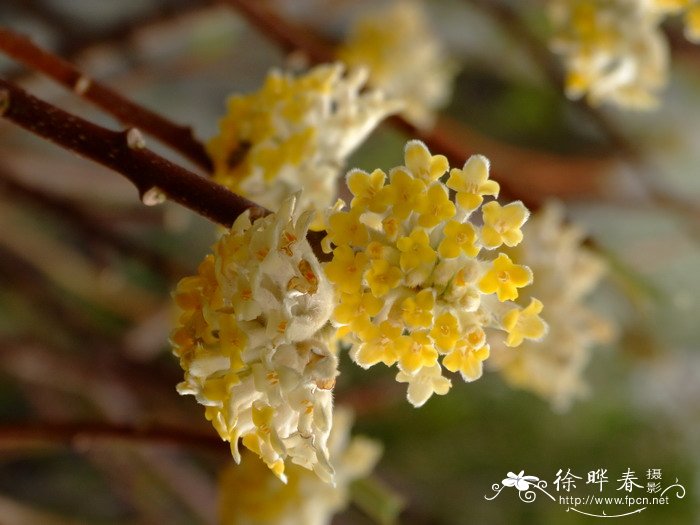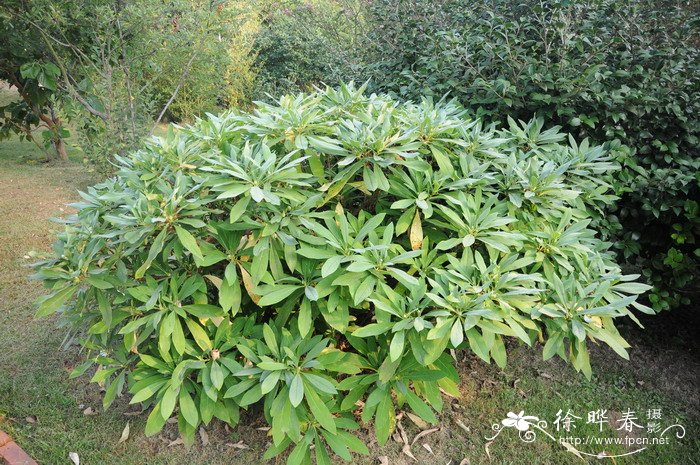结香Edgeworthia chrysantha
中文名(Chinese Name):结香
学名(Scientific Name):Edgeworthia chrysantha Lindl.
英文名(English Common Name):Oriental paperbush
别名(Chinese Common Name):打结花、梦花
异名(Synonym):Edgeworthia papyrifera Siebold et Zucc. Edgeworthia tomentosa (Thunb.) Nakai
科属(Family & Genus):瑞香科(Thymelaeaceae)结香属
形态特征(Description):灌木,高约0.7-1.5米,小枝粗壮,褐色,常作三叉分枝,幼枝常被短柔毛,韧皮极坚韧,叶痕大,直径约5毫米。叶在花前凋落,长圆形,披针形至倒披针形,先端短尖,基部楔形或渐狭,长8-20厘米,宽2.5-5.5厘米,两面均被银灰色绢状毛,下面较多,侧脉纤细,弧形,每边10-13条,被柔毛。头状花序顶生或侧生,具花30-50朵成绒球状,外围以10枚左右被长毛而早落的总苞;花序梗长1-2厘米,被灰白色长硬毛;花芳香,无梗,花萼长约1.3-2厘米,宽约4-5毫米,外面密被白色丝状毛,内面无毛,黄色,顶端4裂,裂片卵形,长约3.5毫米,宽约3毫米;雄蕊8,2列,上列4枚与花萼裂片对生,下列4枚与花萼裂片互生,花丝短,花药近卵形。长约2毫米;子房卵形,长约4毫米,直径约为2毫米,顶端被丝状毛,花柱线形,长约2毫米,无毛,柱头棒状,长约3毫米,具乳突,花盘浅杯状,膜质,边缘不整齐。果椭圆形,绿色,长约8毫米,直径约3.5毫米,顶端被毛。花期冬末春初,果期春夏间。
分布(Distribution):产河南、陕西及长江流域以南诸省区,野生或栽培。美国东南部佐治亚州也有分布,
用途(Use):茎皮纤维可做高级纸及人造棉原料,全株入药能舒筋活络,消炎止痛,可治跌打损伤,风湿痛;也可作兽药,治牛跌打。亦可栽培供观赏。
引自中国植物志英文版:FOC Vol. 13 Page 247
Edgeworthia chrysantha Lindley, J. Hort. Soc. London. 1: 148. 1846.
结香 jie xiang| Thymelaeaceae | Edgeworthia
Edgeworthia papyrifera Siebold & Zuccarini; E. tomentosa (Thunberg) Nakai, comb. rej.; Magnolia tomentosa Thunberg, nom. utique rej.
Shrubs to 0.7-1.5 m tall, deciduous, branching usually trichotomous. Branchlets brown, strong, stout, usually pubescent when young. Leaves falling before anthesis; leaf blade oblong, lanceolate, or oblanceolate, 8-20 × 2.5-5.5 cm, both surfaces whitish gray sericeous, more densely so abaxially, base gradually narrowed, cuneate, apex apiculate; lateral veins 10-13 pairs, slender, curved, pubescent. Inflorescences terminal and axillary, capitate, 30-50-flowered; peduncle 1-2 cm, grayish white hirsute; bracts ca. 10, pilose. Flowers fragrant. Calyx yellow inside, 13-20 × 4-5 mm; tube exterior densely white sericeous; lobes 4, ovate-lanceolate, ca. 3.5 × 3 mm. Anthers subovoid, ca. 2 mm. Disk shallowly cup-shaped, margin irregular. Ovary ovoid, ca. 4 × 2 mm, apex sericeous; style glabrous, ca. 2 mm; stigma globose, ca. 3 mm. Drupe ellipsoid, ca. 8 × 3.5 mm, apex pubescent. Fl. late winter and early spring, fr. spring-summer. 2n = 36*.
● Forests, shrubby slopes, also cultivated. Fujian, Guangdong, Guangxi, Guizhou, Henan, Hunan, Jiangxi, Yunnan, Zhejiang [cultivated and naturalized in Japan].
The name Edgeworthia chrysantha was published a few weeks earlier in 1846 than E. papyrifera and therefore has priority. The oldest name, Magnolia tomentosa , was never generally taken up and was formally rejected to protect E. papyrifera. This means that Nakai’s E. tomentosa is also rejected. "Daphne papyrifera" is not a validly pub lished name: D. Don (Prodr. Fl. Nepal.: 68. 1825) merely cited "D. papyrifera Buchanan-Hamilton" as a synonym of D. odora; later, Siebold (Verh. Batav. Genootsch. Kunsten 12: 22. 1830) commented on the value of "D. papyrifera" for paper-making, referring to E. chrysantha as currently understood, but this is not acceptable as a validating description or diagnosis (see Art. 32.3 of the Vienna Code).


 (责任编辑:徐晔春)
(责任编辑:徐晔春)
学名(Scientific Name):Edgeworthia chrysantha Lindl.
英文名(English Common Name):Oriental paperbush
别名(Chinese Common Name):打结花、梦花
异名(Synonym):Edgeworthia papyrifera Siebold et Zucc. Edgeworthia tomentosa (Thunb.) Nakai
科属(Family & Genus):瑞香科(Thymelaeaceae)结香属
形态特征(Description):灌木,高约0.7-1.5米,小枝粗壮,褐色,常作三叉分枝,幼枝常被短柔毛,韧皮极坚韧,叶痕大,直径约5毫米。叶在花前凋落,长圆形,披针形至倒披针形,先端短尖,基部楔形或渐狭,长8-20厘米,宽2.5-5.5厘米,两面均被银灰色绢状毛,下面较多,侧脉纤细,弧形,每边10-13条,被柔毛。头状花序顶生或侧生,具花30-50朵成绒球状,外围以10枚左右被长毛而早落的总苞;花序梗长1-2厘米,被灰白色长硬毛;花芳香,无梗,花萼长约1.3-2厘米,宽约4-5毫米,外面密被白色丝状毛,内面无毛,黄色,顶端4裂,裂片卵形,长约3.5毫米,宽约3毫米;雄蕊8,2列,上列4枚与花萼裂片对生,下列4枚与花萼裂片互生,花丝短,花药近卵形。长约2毫米;子房卵形,长约4毫米,直径约为2毫米,顶端被丝状毛,花柱线形,长约2毫米,无毛,柱头棒状,长约3毫米,具乳突,花盘浅杯状,膜质,边缘不整齐。果椭圆形,绿色,长约8毫米,直径约3.5毫米,顶端被毛。花期冬末春初,果期春夏间。
分布(Distribution):产河南、陕西及长江流域以南诸省区,野生或栽培。美国东南部佐治亚州也有分布,
用途(Use):茎皮纤维可做高级纸及人造棉原料,全株入药能舒筋活络,消炎止痛,可治跌打损伤,风湿痛;也可作兽药,治牛跌打。亦可栽培供观赏。
引自中国植物志英文版:FOC Vol. 13 Page 247
Edgeworthia chrysantha Lindley, J. Hort. Soc. London. 1: 148. 1846.
结香 jie xiang| Thymelaeaceae | Edgeworthia
Edgeworthia papyrifera Siebold & Zuccarini; E. tomentosa (Thunberg) Nakai, comb. rej.; Magnolia tomentosa Thunberg, nom. utique rej.
Shrubs to 0.7-1.5 m tall, deciduous, branching usually trichotomous. Branchlets brown, strong, stout, usually pubescent when young. Leaves falling before anthesis; leaf blade oblong, lanceolate, or oblanceolate, 8-20 × 2.5-5.5 cm, both surfaces whitish gray sericeous, more densely so abaxially, base gradually narrowed, cuneate, apex apiculate; lateral veins 10-13 pairs, slender, curved, pubescent. Inflorescences terminal and axillary, capitate, 30-50-flowered; peduncle 1-2 cm, grayish white hirsute; bracts ca. 10, pilose. Flowers fragrant. Calyx yellow inside, 13-20 × 4-5 mm; tube exterior densely white sericeous; lobes 4, ovate-lanceolate, ca. 3.5 × 3 mm. Anthers subovoid, ca. 2 mm. Disk shallowly cup-shaped, margin irregular. Ovary ovoid, ca. 4 × 2 mm, apex sericeous; style glabrous, ca. 2 mm; stigma globose, ca. 3 mm. Drupe ellipsoid, ca. 8 × 3.5 mm, apex pubescent. Fl. late winter and early spring, fr. spring-summer. 2n = 36*.
● Forests, shrubby slopes, also cultivated. Fujian, Guangdong, Guangxi, Guizhou, Henan, Hunan, Jiangxi, Yunnan, Zhejiang [cultivated and naturalized in Japan].
The name Edgeworthia chrysantha was published a few weeks earlier in 1846 than E. papyrifera and therefore has priority. The oldest name, Magnolia tomentosa , was never generally taken up and was formally rejected to protect E. papyrifera. This means that Nakai’s E. tomentosa is also rejected. "Daphne papyrifera" is not a validly pub lished name: D. Don (Prodr. Fl. Nepal.: 68. 1825) merely cited "D. papyrifera Buchanan-Hamilton" as a synonym of D. odora; later, Siebold (Verh. Batav. Genootsch. Kunsten 12: 22. 1830) commented on the value of "D. papyrifera" for paper-making, referring to E. chrysantha as currently understood, but this is not acceptable as a validating description or diagnosis (see Art. 32.3 of the Vienna Code).
踩一下[1]

顶一下[6]